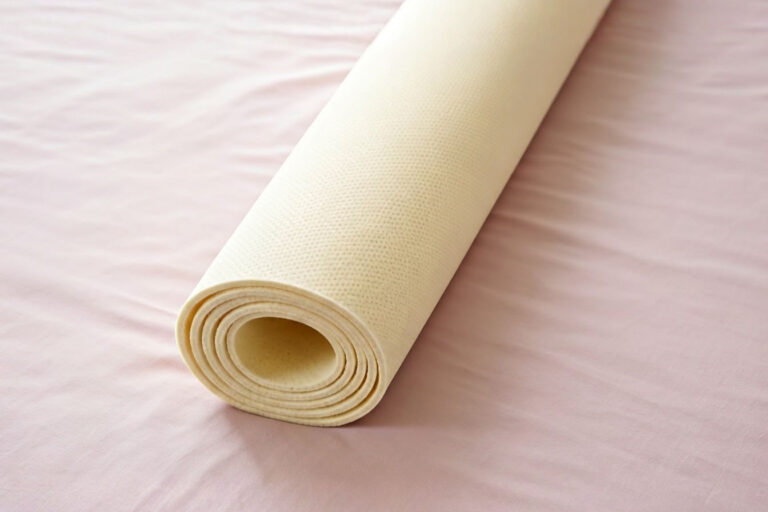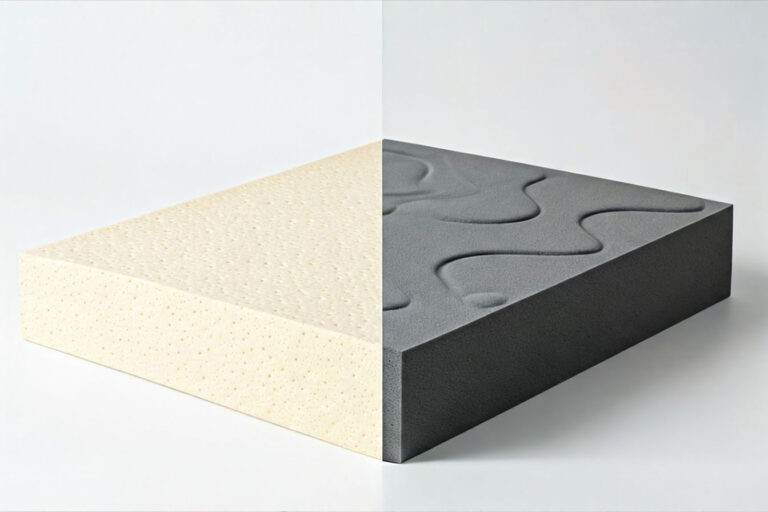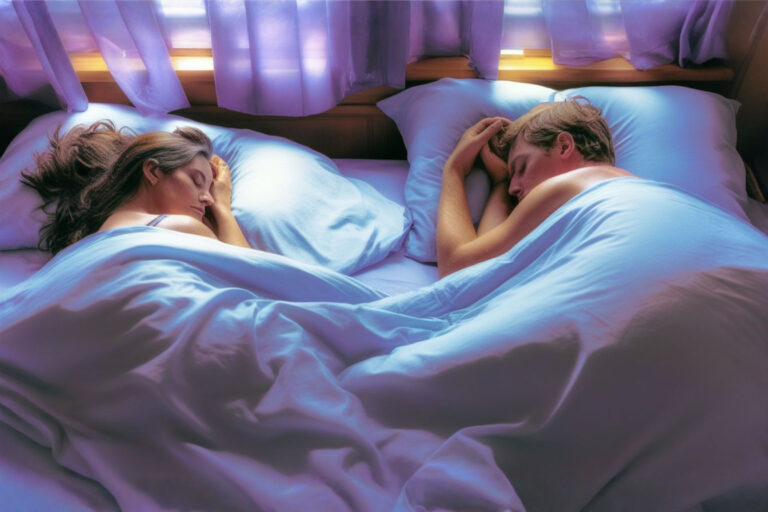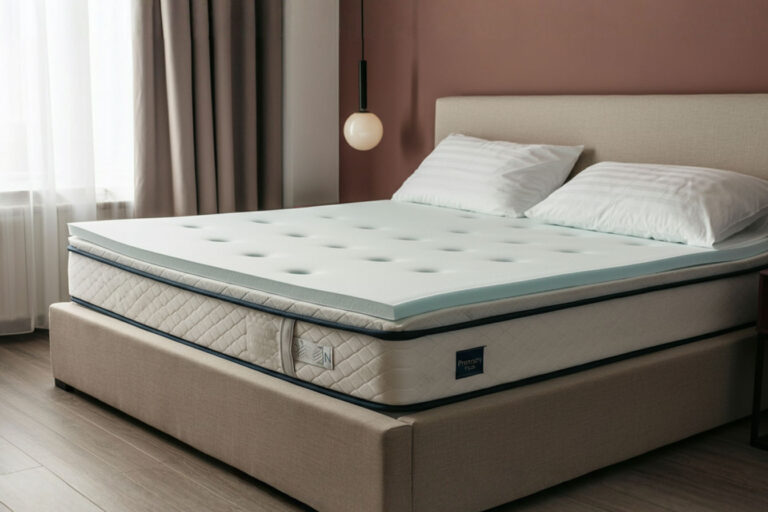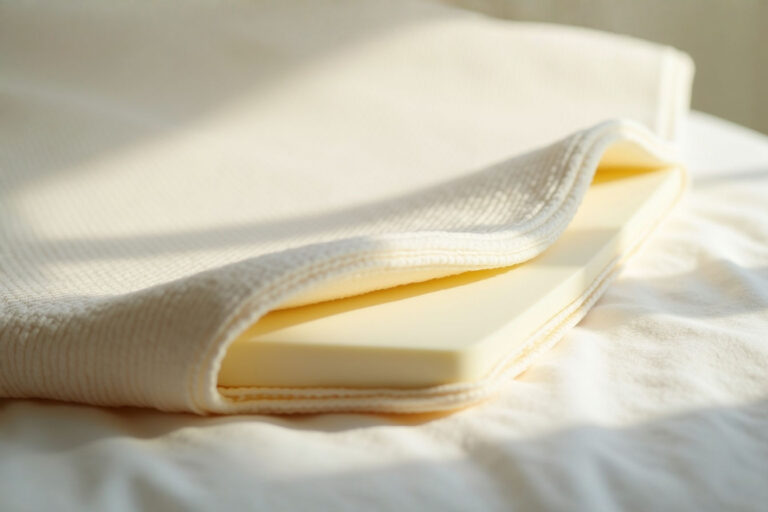Egg Crate Mattress Topper: The Under-$50 Fix for Dorm Mattresses That Feel Like Concrete
Struggling with a rock-hard dorm bed? Discover how a simple egg crate mattress topper can transform your sleep quality without breaking your student budget.

You’ve packed your favorite bedding, a cozy comforter, and soft pillows for your dorm room. But on move-in day, you discover the truth that generations of college students have faced before you: dorm mattresses feel like slabs of concrete. They’re stiff, noisy, and about as comfortable as sleeping on the floor.
Don’t worry – you don’t have to suffer through four years of bad sleep. There’s an affordable solution that won’t drain your already tight student budget: the egg crate mattress topper.
This simple foam pad can transform your rock-hard dorm bed into a much more comfortable sleeping spot. And the best part? You can find one for under $50, making it one of the smartest and most affordable dorm room investments you’ll make.
Let’s explore how this inexpensive bedding hack can save your sleep, your back, and your college experience.
What Is an Egg Crate Mattress Topper?
Before spending your money, it helps to understand what you’re buying. An egg crate mattress topper is a layer of foam that sits on top of your mattress to add comfort.
The Distinctive Egg Carton Design Explained
The name “egg crate” comes from its unique design. One side of the topper has a bumpy surface that looks like the inside of an egg carton. These bumps (or peaks and valleys) aren’t just for show – they serve an important purpose.
The raised bumps help distribute your body weight more evenly and reduce pressure on parts of your body that normally press harder into the mattress. This design also creates small air pockets that help with airflow, keeping you cooler while you sleep.
Common Materials and Construction
Most egg crate toppers are made from polyurethane foam. This is a synthetic material that feels soft but still offers support. Some pricier versions might use memory foam, which molds to your body shape more precisely.
The foam density affects how the topper feels. Lighter, less dense foam feels softer but won’t last as long. Denser foam provides more support and lasts longer but might feel firmer.
Most budget-friendly egg crate toppers are made from a single piece of foam with no cover. Some come with a removable, washable cover that helps keep the topper clean.
Standard Sizes and Thickness Options
Egg crate toppers come in all standard mattress sizes, including Twin XL – the most common size in dorm rooms. Before buying, check your dorm bed size to make sure you get the right fit.
Thickness is another important factor. These toppers typically range from 1 to 4 inches thick. For a really firm dorm mattress, a 2-3 inch topper often provides the best balance of comfort and value. Thinner toppers (1-1.5 inches) might not add enough cushioning for very firm mattresses, while thicker ones (3-4 inches) cost more but provide extra softness.
Why Dorm Mattresses Feel Like Concrete (And Why It Matters)
If you’ve ever wondered why colleges seem to provide the most uncomfortable mattresses possible, there are actually a few practical reasons behind this discomfort.
The Truth About Institutional Mattresses
Dorm mattresses are made to last through years of different students using them. They’re designed to withstand wear and tear, not to provide cloud-like comfort. Most dorm beds use institutional mattresses that are:
- Extra firm for durability
- Covered in waterproof or water-resistant material
- Made to meet fire safety standards
- Designed to fit standard bed frames
- Built to endure years of use without sagging
These practical concerns explain why comfort comes last on the priority list. The plastic-like mattress covers that protect against spills and bugs also make the beds feel stiffer and can cause night sweats.
How Poor Mattresses Affect Your Sleep and Academic Performance
The quality of your sleep directly impacts your ability to succeed in school. Poor sleep from an uncomfortable mattress can lead to:
- Trouble concentrating in class
- Difficulty remembering what you studied
- Lower grades and test scores
- Weakened immune system (making you more likely to get sick)
- Mood problems like irritability and even depression
- Increased stress levels
Research shows that college students already don’t get enough sleep. One study found that 70% of college students report getting insufficient sleep. An uncomfortable mattress makes this problem even worse.
Common Complaints from College Students
Ask any college student about their dorm bed, and you’ll likely hear these common complaints:
- “It feels like sleeping on a rock”
- “I wake up with back pain every morning”
- “The plastic cover makes me sweat”
- “I can feel every spring poking into my back”
- “I toss and turn all night trying to get comfortable”
- “The mattress is so noisy every time I move”
These issues affect not just your comfort but your overall dorm experience. When you’re uncomfortable at night, it affects your mood, energy, and ability to enjoy college life.
5 Benefits of Egg Crate Mattress Toppers for Dorm Beds
Now that you understand why dorm mattresses are so uncomfortable, let’s look at how an egg crate mattress topper can help solve these problems.
Affordability Factor: Why Under $50 Matters for Students
College comes with enough financial stress. Between tuition, books, and basic living expenses, most students can’t afford to spend hundreds on a luxury mattress topper.
Basic egg crate toppers often cost between $20-$50, making them one of the most budget-friendly sleep solutions. Even with a tight student budget, this small investment can dramatically improve your daily life.
The affordability means you can replace it every year or two if needed, which is perfect for the temporary nature of dorm living. You’re not investing in a forever item – just something to get you through your college years comfortably.
Pressure Point Relief and Body Contouring
Those bumpy egg-shaped peaks and valleys do an important job: they help distribute your body weight more evenly across the mattress. This design reduces pressure on areas like your shoulders, hips, and knees.
When you lie on a firm surface, certain parts of your body bear more weight. This uneven pressure can cause pain and discomfort, especially after a full night of sleep. The egg crate design allows those pressure points to sink slightly into the valleys while still supporting the rest of your body.
For side sleepers especially, this pressure relief can make a huge difference in comfort and reduce morning aches and pains.
Improved Air Circulation and Temperature Regulation
Do you tend to get hot while sleeping? Many dorm rooms lack proper climate control, and those plastic-covered institutional mattresses make the problem worse by trapping body heat.
The egg crate design creates channels for air movement between your body and the mattress. This improved airflow helps regulate temperature and can reduce night sweats.
Better air circulation also helps prevent moisture build-up, which can lead to mold and mildew – especially important in humid dorm environments.
Lightweight and Easy to Transport During Moves
College life involves a lot of moving – from home to dorm, from dorm to dorm, and eventually to an apartment or back home during breaks. A standard egg crate topper is lightweight and flexible enough to roll or fold.
Most weigh between 2-5 pounds, making them easy to carry up stairs or across campus. This portability is a huge advantage over heavier mattress toppers that can weigh 15-20 pounds or more.
Many students even bring their egg crate toppers home during longer breaks, especially if they’ve gotten used to sleeping on one.
Provides a Hypoallergenic Barrier
Dorm mattresses have been used by many students before you. Despite regular cleaning, they can harbor dust mites, allergens, and other irritants that affect your breathing and sleep quality.
A foam egg crate topper creates a barrier between you and the old mattress. While basic foam isn’t fully hypoallergenic, it does provide a fresh layer that hasn’t been used by dozens of other students.
For even better protection, look for a topper with an allergen-proof cover or add a mattress protector on top of your egg crate.
Choosing the Right Egg Crate Topper for Your Dorm Bed
Not all egg crate toppers are created equal. Here’s how to pick the right one for your specific needs.
Understanding Dorm Bed Sizes (Twin XL vs. Standard)
Most dorm beds use Twin XL mattresses – they’re the same width as a standard twin (38-39 inches) but 5 inches longer (80 inches instead of 75). This extra length accommodates taller students.
Before shopping, confirm your dorm bed size. Some smaller colleges might use standard twin beds, while a few use full-size mattresses in certain dorms.
Buying the wrong size can lead to awkward overhangs or gaps. A topper that’s too small won’t cover the entire sleeping surface, while one that’s too large might bunch up against the wall.
Thickness Options: What’s Best for Different Sleep Styles
The thickness you choose depends on your sleep position and comfort preferences:
- 1-1.5 inch toppers: Provide minimal cushioning. Good for back sleepers who just need a little softening of a firm mattress. These are the most affordable but offer the least comfort improvement.
- 2 inch toppers: The most popular thickness. They provide a good balance of comfort and support for most sleepers. They’re also reasonably priced, usually under $40 for a Twin XL.
- 3-4 inch toppers: Offer the most cushioning and are best for side sleepers or for very firm mattresses. These will be at the higher end of the price range but provide the greatest comfort improvement.
Remember that thicker isn’t always better. A topper that’s too thick and soft might not provide enough support, leading to different kinds of discomfort.
Material Considerations (Standard Foam vs. Memory Foam)
Basic egg crate toppers use standard polyurethane foam. This material:
- Responds quickly when you move
- Returns to its original shape immediately
- Feels more bouncy
- Is the most affordable option
- Doesn’t trap as much heat
Memory foam egg crate toppers are also available. These:
- Conform more closely to your body shape
- Return to shape slowly when pressure is removed
- Feel more cushioning and “huggy”
- Cost more than standard foam
- May trap more body heat
For most dorm students, standard foam provides the best value and practicality. Memory foam options offer more comfort but usually exceed the $50 price point.
Budget Considerations and Price-to-Quality Ratio
Within the under-$50 range, there are still different price points:
- $15-25 range: These basic options usually feature thinner foam (1-1.5 inches) with lower density. They’ll improve comfort somewhat but may compress quickly and need replacement after a semester or two.
- $25-40 range: Mid-range toppers offer better durability with 2-inch thickness and medium-density foam. This is the sweet spot for most college students, balancing price and quality.
- $40-50 range: Premium economy options might offer thicker foam (2.5-3 inches), higher density, or features like antimicrobial treatments. These should last for at least a full school year with proper care.
Look for sales during back-to-school season when retailers often discount dorm bedding items. Online retailers also frequently offer better prices than physical stores.
Egg Crate vs. Other Mattress Toppers: Which Is Best for College?
Egg crate isn’t the only mattress topper option out there. How does it compare to other types available on the market?
Memory Foam: Comfort vs. Cost Comparison
Memory foam toppers mold to your body’s exact shape, creating a custom-feeling sleep surface. They excel at pressure relief and can be very comfortable.
However, they come with significant drawbacks for dorm use:
- Higher cost: Most quality memory foam toppers start at $80-100 and go up from there
- Heavy weight: They’re much heavier and harder to move
- Heat retention: Many memory foam toppers trap body heat
- Odor concerns: New memory foam often has a strong chemical smell for the first few days
While memory foam provides superior comfort, the higher price and practical concerns make them less ideal for temporary dorm living.
Gel and Fiber-Filled Toppers: Pros and Cons
Gel toppers incorporate cooling gel into foam or as a separate layer. They sleep cooler than regular foam but cost significantly more – usually $70-150 for a Twin XL.
Fiber-filled toppers (sometimes called mattress pads) contain polyester fill similar to what’s in pillows. They add softness but provide less support and pressure relief than foam options. They range from $30-80 depending on thickness and quality.
The main advantages of fiber-filled toppers are that they’re washable and don’t trap as much heat. However, they flatten more quickly and don’t provide the same pressure relief as foam.
Why Egg Crate Often Wins for College Students
For most college students, egg crate toppers hit the sweet spot of affordability, practicality, and comfort improvement. They win for dorm use because:
- Budget-friendly: They fit within tight student budgets
- Lightweight: Easy to transport during frequent moves
- Effective improvement: They significantly upgrade mattress comfort
- Low commitment: If they get damaged, replacing them isn’t a financial disaster
- Widely available: Easy to find in stores and online
While not the absolute most comfortable option on the market, egg crate toppers offer the best value for a temporary living situation like a dorm room.
Setting Up and Maintaining Your Egg Crate Topper
Once you’ve chosen your egg crate topper, you’ll need to know how to use and care for it properly.
Proper Positioning and Keeping It in Place
When you unpack your topper, place it bumpy side up on your mattress. The egg crate pattern should face your body to provide the pressure-relieving benefits.
To keep it from sliding around:
- Use a fitted sheet that’s deep enough to go over both your mattress and topper
- Consider a non-slip mattress pad underneath if sliding is a major issue
- Some students use safety pins in the corners to secure the topper to the mattress (just be careful not to damage the mattress)
For lofted beds or bunk beds, make sure the topper is fully centered on the mattress before adding sheets. This prevents awkward overhangs that might lead to the topper shifting when you climb in and out of bed.
Using with Mattress Protectors and Fitted Sheets
Most dorm beds already have a mattress protector, but you might want to add your own for extra cleanliness. Here’s the ideal layering from bottom to top:
- Mattress
- Mattress protector (optional additional one)
- Egg crate topper
- Fitted sheet
Look for deep-pocket fitted sheets since you’re now adding 1-3 inches to your mattress height. Regular fitted sheets might pop off during the night. If you can’t find deep-pocket sheets, sheet fasteners or suspenders can help keep regular sheets in place.
When making your bed, tuck the fitted sheet around both the mattress and topper to create a unified sleeping surface.
Cleaning Methods That Won’t Damage the Foam
Most egg crate toppers can’t be machine washed without risking damage. Instead, try these cleaning methods:
For routine cleaning:
- Vacuum the topper using an upholstery attachment
- Sprinkle baking soda on the topper, let it sit for a few hours, then vacuum it up to remove odors
For spot cleaning:
- Mix mild soap with warm water
- Lightly dampen a clean cloth (don’t soak it)
- Gently dab at the stain (don’t rub hard)
- Let air dry completely before reusing
For deeper cleaning:
- Spray with a fabric refresher like Febreze
- Use an enzymatic cleaner for biological stains (follow product directions)
- Consider a mattress topper cover that can be removed and washed
Never put foam egg crate toppers in washing machines or dryers, as this can tear the foam and destroy the egg crate pattern.
Preventing Mold and Mildew in Humid Dorms
Dorm rooms can get humid, especially in older buildings or warmer climates. Moisture trapped in foam can lead to mold and mildew, which causes odors and potential health issues.
To prevent moisture problems:
- Air out your topper regularly by removing sheets when you’re away for the day
- Use a dehumidifier in your room if humidity is a persistent issue
- Make sure your topper is fully dry after any cleaning before putting sheets back on
- Flip the topper occasionally to allow both sides to breathe
- Avoid eating or drinking in bed to prevent spills
If your topper does develop a musty smell, try the baking soda method mentioned above or place it in a sunny, well-ventilated area for a few hours. Sunlight naturally kills many mold spores.
Storage Solutions for Breaks and Summers
During breaks when you’re away from the dorm, proper storage will extend your topper’s life.
For short breaks (1-2 weeks):
- Leave the topper on your bed if allowed
- If you must remove it, roll it loosely and store in a dry closet
For summer or longer breaks:
- Clean and fully dry the topper before storage
- Roll it up loosely (avoid folding which creates permanent creases)
- Store in a breathable bag (not sealed plastic which can trap moisture)
- Keep in a cool, dry place away from direct sunlight
Some toppers come with storage bags, but a clean trash bag with a few small holes punched in it works too. Just don’t compress the topper tightly for long periods, as this can damage the foam structure.
Real Students’ Experiences: Before and After the Egg Crate
Nothing speaks to the value of egg crate toppers like the experiences of students who’ve used them. Here’s what real college students have to say about their before-and-after experiences.
Testimonials about Improved Sleep Quality
“I spent my entire first semester tossing and turning on that awful dorm mattress. After winter break, I brought back a 2-inch egg crate topper that cost me $30. The difference was immediate. I actually started sleeping through the night for the first time since starting college.” – Jamie, Sophomore
“As someone who’s struggled with insomnia, I was worried about sleeping in a dorm. My RA recommended an egg crate topper, and I’m so glad I listened. It doesn’t make the bed feel like home, but it’s comfortable enough that I can fall asleep without counting ceiling tiles for hours.” – Taylor, Freshman
“The plastic mattress cover in my dorm made me sweat so much. Adding an egg crate topper created some airflow between me and that plastic nightmare. I sleep much cooler now.” – Alex, Junior
Reports on Back Pain Reduction
Many students report that egg crate toppers helped with the back and neck pain that often comes from institutional mattresses.
“I developed lower back pain within two weeks of moving into my dorm. My mom suggested an egg crate topper. The pain didn’t disappear completely, but it reduced enough that I could focus on my classes instead of my aching back.” – Chris, Freshman
“I’m a side sleeper, and my hip would hurt every morning after sleeping on the dorm mattress. A 3-inch egg crate topper fixed that issue almost immediately. Worth every penny of the $45 I spent.” – Morgan, Sophomore
“As an athlete, recovery sleep is crucial. The dorm beds were wrecking my back until I added an egg crate topper. Now I wake up feeling much less stiff and sore.” – Jordan, Junior
Cost-Benefit Analysis from Student Perspectives
Students consistently report that egg crate toppers offer excellent value for the price.
“When you break it down, I spent $35 on my topper. Over a school year, that’s about 10 cents per night for much better sleep. Best deal on campus!” – Casey, Senior
“I tried cheaper alternatives first – extra blankets under the sheet, a mattress pad, even a sleeping bag on top of the mattress. Nothing worked. The egg crate topper was worth the $30 I eventually spent on it.” – Riley, Sophomore
“My roommate bought an expensive memory foam topper for $120, and I got an egg crate for $40. Honestly, there’s not enough difference in comfort to justify the price gap. We’re both sleeping fine now.” – Skyler, Freshman
Most students agree that the modest investment in an egg crate topper pays off in better sleep, improved academic focus, and a more positive overall college experience.
Common Questions About Egg Crate Mattress Toppers
Let’s address some frequently asked questions about egg crate mattress toppers.
How long do egg crate toppers typically last?
With regular use, most budget egg crate toppers last about 1-2 years before they start to lose their cushioning properties. Signs that your topper needs replacement include:
- Flattened bumps in the egg crate pattern
- Visible compression that doesn’t bounce back
- Crumbling foam edges
- Discoloration that doesn’t clean out
Higher density foam toppers may last longer, while lower quality ones might need replacement after just one semester. For most students, planning to replace your topper every school year is a reasonable approach.
Can I wash my egg crate mattress topper?
Standard egg crate toppers cannot be machine washed or submerged in water. Foam absorbs water like a sponge and takes days to dry, which can lead to mold growth.
Instead of washing the entire topper, spot clean as needed following the methods mentioned earlier. Some toppers come with removable, washable covers, which are a great feature if you can find them within your budget.
If your topper becomes severely soiled, replacement is often more practical than attempting a full cleaning.
Will an egg crate topper help with back pain?
Many students report reduced back pain after adding an egg crate topper to their dorm mattress. The egg crate design helps distribute body weight more evenly and reduces pressure on key areas like the shoulders, hips, and lower back.
However, egg crate toppers aren’t medical devices. If you have serious back problems, consult a doctor for recommendations. For some conditions, you might need a firmer or more supportive surface rather than the softness an egg crate provides.
For the typical soreness caused by an overly firm dorm mattress, an egg crate topper can make a significant difference.
Do egg crate toppers make you hot?
Compared to solid foam or memory foam toppers, egg crate designs actually sleep cooler. The peaks and valleys create air channels that improve ventilation and reduce heat buildup.
That said, any foam product will be warmer than sleeping directly on the mattress. If you’re very sensitive to heat while sleeping:
- Look for “open-cell” foam toppers that promote better airflow
- Choose a thinner topper (1-2 inches instead of 3-4)
- Use breathable cotton sheets rather than synthetic materials
- Consider a cooling mattress pad on top of the egg crate if heat is a major issue
What thickness should I choose for a very firm mattress?
For extremely firm dorm mattresses (the “sleeping on concrete” variety), a 3-inch egg crate topper usually provides the best balance of comfort and value while staying under $50.
If budget allows, some students prefer the 4-inch options for maximum cushioning, though these might exceed the $50 price point slightly.
Keep in mind that thicker toppers require deeper-pocket fitted sheets and can make lofted beds feel even higher. If you’re in a top bunk, a 2-inch topper might be more practical to maintain adequate ceiling clearance.
Your Path to Better Sleep in the Dorm
After exploring all aspects of egg crate mattress toppers, the verdict is clear: they’re one of the smartest investments a college student can make.
For less than $50 – often much less during back-to-school sales – you can transform your sleep experience in the dorm. While these affordable toppers won’t turn an institutional mattress into a luxury hotel bed, they make enough difference to improve your sleep quality significantly.
Better sleep means better academic performance, improved mood, and higher energy levels. All of these factors contribute to a more positive college experience overall.
When you consider that you’ll spend around 2,500 hours in your dorm bed during a school year, investing $30-50 in making those hours more comfortable seems like a no-brainer. That breaks down to just pennies per hour of improved sleep.
Whether you’re a current student suffering on a rock-hard mattress or an incoming freshman trying to prepare, add an egg crate mattress topper to your essential dorm shopping list. Your body will thank you, and your future well-rested self will appreciate your wisdom.
After all, college is challenging enough without fighting for sleep every night. With this simple, affordable solution, you can cross “uncomfortable bed” off your list of college worries and focus on what really matters – your education, experiences, and friendships that will last long after you’ve graduated from that dorm room.


